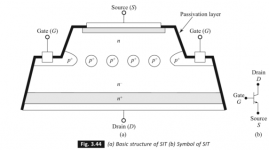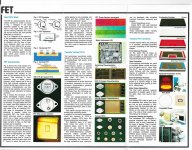After more than 30 years with DIY audio I'm considering to retire from DIY.
It had been great fun most of the time and could I stack the money spend during the period I today could have bought some very serious audio equipment and live happily ever after.
That said I do consider the Firstwatt SIT2 and maybe even the SIT1 monos but I came by this thread:
"When I initially received the SIT-2, it was dead quiet. After three weeks, it started intermittently making a crackling static noise in the right channel. That went away, but a short time later, it started constantly making the crackling static noise in the left channel. It was noticeable during soft passages of music. I thought the amp had developed an issue. I was sent out a second another SIT-2 amp. The second SIT-2 amp immediately made the same static crackling noise in the right channel. I was told that SIT amp does make a popcorn type noise that can change over time."
I dislike any kind of noise as my current setup is dead silent (J2 variant amp and 98dB/1W speakers).
Anyone heard about this issue before? NP?
It had been great fun most of the time and could I stack the money spend during the period I today could have bought some very serious audio equipment and live happily ever after.
That said I do consider the Firstwatt SIT2 and maybe even the SIT1 monos but I came by this thread:
"When I initially received the SIT-2, it was dead quiet. After three weeks, it started intermittently making a crackling static noise in the right channel. That went away, but a short time later, it started constantly making the crackling static noise in the left channel. It was noticeable during soft passages of music. I thought the amp had developed an issue. I was sent out a second another SIT-2 amp. The second SIT-2 amp immediately made the same static crackling noise in the right channel. I was told that SIT amp does make a popcorn type noise that can change over time."
I dislike any kind of noise as my current setup is dead silent (J2 variant amp and 98dB/1W speakers).
Anyone heard about this issue before? NP?
Pa made later revision (harmful sound-wise) of circuits , to increase idiot-proof* level of his SIT amps , so do not worry
*some preamps are sending idiotically high either negative or positive spike from output , when powering up ;after prolonged period of repeating same thing , that made some nasty thing to SIT's gate
anyway , to repeat - that issue covered in later production , same as for guys having first production specimens
*some preamps are sending idiotically high either negative or positive spike from output , when powering up ;after prolonged period of repeating same thing , that made some nasty thing to SIT's gate
anyway , to repeat - that issue covered in later production , same as for guys having first production specimens
Pa made later revision (harmful sound-wise) of circuits , to increase idiot-proof* level of his SIT amps .....
of course , my Firefox spell-checker isn't enough idiot-proof

that means to be non-harmful

So, does a SiT still have an oxide gate, similar to MOSFETs, where the thickness of the oxide imposses a breakdown voltage to Vgs reliability?
No. SITS are a variety of Jfet, they have a pn junction, not an isulating layer.
They are not the quietest of transistors by virtue of some gate leakage and a few have been replaced for noise, which is higher if the source impedance is high.
Because the noise is in Gate current, it will depend on the source impedance,
so check to see if the noise is different with and without the input buffer.
And we are getting down to a small quantity of spares. The day may come when
you have to choose between a noisy SIT and a new replacement semiconductor.
so check to see if the noise is different with and without the input buffer.
And we are getting down to a small quantity of spares. The day may come when
you have to choose between a noisy SIT and a new replacement semiconductor.
A P-N junction is formed at the boundary between P-type and N-type dopants within the channel itself, while a silicon dioxide insulating layer is the dielectric between the gate and channel.
The name V-FET denotes vertical MOSFET. The gate and source terminals are isolated by a markedly thick, homogeneous silicon dioxide layer, no epitaxial layer is applied to the source. The epitaxial layer is always associated with substantial crystalline defects.
A low voltage drop is one of the distinct characteristics of the P-N junction diode which corresponds poorly to the very high cut-off voltage of the Sony devices.
V-FETs do not generate crackling noises, bad connections do.
The name V-FET denotes vertical MOSFET. The gate and source terminals are isolated by a markedly thick, homogeneous silicon dioxide layer, no epitaxial layer is applied to the source. The epitaxial layer is always associated with substantial crystalline defects.
A low voltage drop is one of the distinct characteristics of the P-N junction diode which corresponds poorly to the very high cut-off voltage of the Sony devices.
V-FETs do not generate crackling noises, bad connections do.
A P-N junction is formed at the boundary between P-type and N-type dopants within the channel itself, while a silicon dioxide insulating layer is the dielectric between the gate and channel.
The name V-FET denotes vertical MOSFET. The gate and source terminals are isolated by a markedly thick, homogeneous silicon dioxide layer, no epitaxial layer is applied to the source. The epitaxial layer is always associated with substantial crystalline defects.
A low voltage drop is one of the distinct characteristics of the P-N junction diode which corresponds poorly to the very high cut-off voltage of the Sony devices.
V-FETs do not generate crackling noises, bad connections do.
I disagree. I recently had a conversation with a customer who is a PhD power semiconductor professor. This guy operates a wafer fab at a major power semiconductor university. An SIT is a permeable gate JFET. It is not a MOSFET. A BSIT (Bipolar SIT) is a permeable base BJT.
Last edited:
An SIT is a permeable gate JFET.
Which SIT? Permeable to what?
Frankly, I don`t know who came up with the lofty name Static Induction Transistor, maybe some semiconductor professor. The Japanese called it "Vertical Field Effect Transistor", exactly what it is.
Names can signify anything. Names are extraneous, electrical properties are of importance.
Which SIT? Permeable to what?
Frankly, I don`t know who came up with the lofty name Static Induction Transistor, maybe some semiconductor professor. The Japanese called it "Vertical Field Effect Transistor", exactly what it is.
Names can signify anything. Names are extraneous, electrical properties are of importance.
Permeable as in a mesh or a comb physical shape. Triode-like behavior at Vgs <= 0 and pentode-like behavior above Vgs > 0. The Semisouth Pass SIT link attached.
http://indel.etfbl.net/2014/resources/Proceedings_2014/INDEL_2014_Paper_04.pdf
An externally hosted image should be here but it was not working when we last tested it.
The name V-FET denotes vertical MOSFET. The gate and source terminals are isolated by a markedly thick, homogeneous silicon dioxide layer, no epitaxial layer is applied to the source.
So, according to you, SIT or static induction transistor is variant of MOSFET (metal–oxide–semiconductor field-effect transistor). Would you care to identify metal oxide gate insulation on this SIT cross section, for the benefit of all us that are delusional to think otherwise?
Attachments
No. SITS are a variety of Jfet,
Attachments
- Status
- This old topic is closed. If you want to reopen this topic, contact a moderator using the "Report Post" button.
- Home
- Amplifiers
- Pass Labs
- Firstwatt SIT noise issues?

